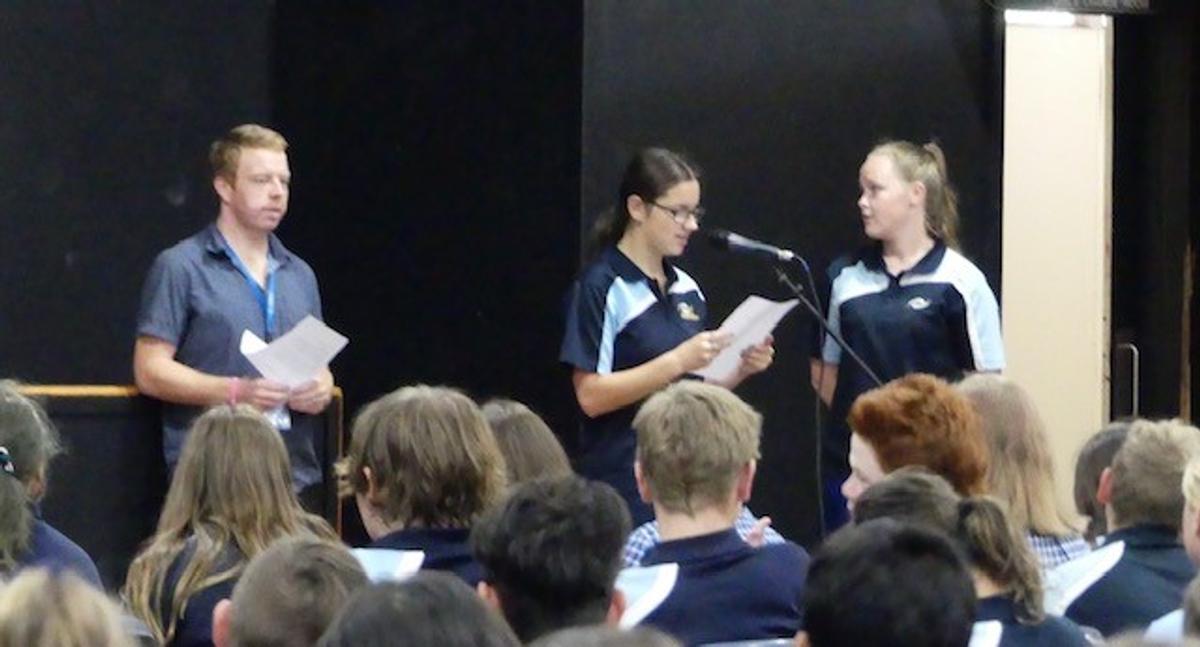Wellbeing

Love me, love you
Tamika Mosman and Madeline Post started the assembly with Acknowledgment to Country. Caitlyn Knight and Lizzy Bain introduced Warren Davies, aka 'The Unbreakable Farmer', who presented the 'Love Me, Love You' to the whole school as part of our mental health program.
The aim of the session was to raise awareness, reduce stigma and provide participants with simple coping mechanisms that can help on a day to day basis including; support networks, mindfulness and wellbeing conversations.
'Love Me, Love You' programs have been created in collaboration with mental health and education professionals and all programs meet Australian Curriculum standards.
The programs have been shown to assist schools in improving the wellbeing of their students while teaching them important skills for coping with life’s hardships and mental health challenges. Students learning key mental health concepts is the cornerstone to the programs, with the overall aim to empower students to take control over their own mental health by looking after their wellbeing.
Live 4 Life
Six students from Cobram Secondary College have become one of the first crew members of the Live 4 Life program.
Live 4 Life is a whole community approach to teenage mental health, giving students the skills to look after themselves and each other. Live 4 Life started 10 years ago, in the Macedon ranges and we are excited to see it grow in Moira. Students came up with the theme 'Don't hesitate to communicate' and will organise a launch, where all Year 8's from accross the Shire will attend which will be a unique and groundbreaking way to promote mental health and wellbeing in our young people and then hopefully impacting our wider comunity.
The Cobram Secondary College Crew are now busy organising and contributing toward the big launch in March. They have already raised $1500, thanks to Cobram Health's Commonwealth Bank grant for healthy communities, if you would like to support please contact us.
Guidelines for Healthy Growth & Development
Guidelines for Healthy Growth & Development for Children & Young People (5 to 17 years).
For optimal health, children and young people (5–17 years) should achieve the recommended balance of high levels of physical activity, low levels of sedentary behaviour and sufficient sleep each day. Children and young people should participate in a range of physical activities such as active play and recreation, sports, hobbies, chores, and jobs while maintaining good quality sleep and limiting screen time and prolonged sitting. Whether at home or school, indoors or outdoors, on the field or in the water, moderate to vigorous physical activity can provide health benefits.
Physical Activity
Children and young people should aim for at least 60 minutes of moderate to vigorous physical activity per day involving mainly aerobic activities that make their heart beat faster – more is better. The 60 minutes can be made up of shorter bursts of activity throughout the day that add up to 60 minutes or longer.
Activities that are vigorous, as well as those that strengthen muscle and bone, should be incorporated (in the recommended 60 minutes of daily physical activity) at least three days per week. In addition, several hours of a variety of light physical activities should be undertaken each day.
Tips:
- Basketball, soccer, netball, lap swimming, skipping or running are all great ways to add more vigorous activity to a day. They don’t have to be organised, paid activities – they can be as simple as grabbing a ball or a friend and running around at the park. Anything that makes kids ‘huff and puff’ counts!
- Add to the daily total with moderate-intensity activities such as bike riding, scootering or skateboarding. Swap a drive to the local shops or library with a bike or scooter ride.
- Examples of light activities include leisurely walking or playing handball. Walking your dog or to school is a great way to increase light activity. Some activity is better than none.
- Great options to strengthen muscles and bones include skipping, running, yoga, jumping, push-ups, sit-ups, lifting weights, lunges, squats, climbing trees or swinging on monkey bars.
- Try to switch sitting for being active. Meet friends for a game in the park rather than spend your leisure time sedentary on a screen. These small changes will deliver health benefits, but remember to maintain sufficient sleep.
Sedentary Behaviour
Long periods of sitting can counteract the benefits of being physically active so it should be broken up as often as possible.
Sedentary recreational screen time should be limited to 2 hours per day. This does not include screen-based activities for educational uses.
Tips:
- Parents: be your child’s role model and keep your own screen time to a minimum and be active too.
- Parents: leave the car at home and ride or walk together to your local activities. Be active together on the weekends by taking a nature walk or learning a new activity such as rock climbing.
Sleep
Sleep is essential for optimal health.
Children (5-13 years) should have 9 to 11 hours of uninterrupted sleep per night and young people (14-17 years) should have 8 to 10 hours of uninterrupted sleep per night.
To establish and maintain healthy sleep patterns, children and young people should have a consistent bedtime routine, avoid screen time before sleep, and keep screens out of the bedroom.
Tips:
- To keep a consistent routine try not to vary bedtime and wake-up times by more than 30 minutes.
- Avoid screens one hour before going to bed.
- Make bedrooms a screen-free zone.
FOR MORE INFORMATION, VISIT WWW.HEALTH.GOV.AU






